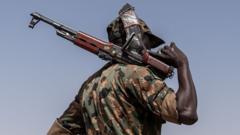The ongoing conflict in Sudan has taken a decisive turn as the oil-rich Kordofan region emerges as the key battleground in a war that has ravaged the country for over two years. Attacks that have claimed the lives of hundreds of civilians have spotlighted the significance of Kordofan, where controlling the territory translates to mastering Sudan’s oil supply. Amir Amin, a risk analysis expert from Oasis Policy Advisory, emphasizes that the stakes are exceedingly high; whoever conquers Kordofan not only influences the oil flow but also asserts control over a major segment of Sudan.
Kordofan's strategic importance extends beyond Sudan, as it plays a critical role for neighboring South Sudan, whose oil is transported through Kordofan’s pipelines before reaching the international market. The current population of the region, estimated at nearly eight million, is witnessing intensified confrontations since June, with the army aggressively targeting the Rapid Support Forces (RSF) to reclaim territory. This intensified engagement follows the RSF's prior substantial territorial gains, which included the capture of Khartoum, the capital of Sudan, and the vital Gezira state.
Military leader General Abdel Fattah al-Burhan’s sporadic visits to Khartoum highlight the gravity of the situation, revealing a damaged capital beleaguered by violence. With the ongoing conflict having resulted in approximately 150,000 fatalities and displacing around 12 million people, the humanitarian crisis is dire. The RSF initially allied with Burhan during the 2021 coup but subsequently turned against him, leading to an internal power struggle that escalated into open warfare in April 2023.
Analysts, including Alan Boswell from the International Crisis Group, suggest that defeating the RSF in Kordofan is part of the army’s larger strategic plan to advance into Darfur, the birthplace of the RSF. Conversely, the RSF aims to seize Kordofan to regain momentum and threaten the heart of Sudan again. Local dynamics are further complicated by the ethnic composition of the RSF, with many fighters arising from the Misseriya group in West Kordofan, who are likely to defend their communities vigorously.
Recent airstrikes in locations like el-Fula and Abu Zabad have exacerbated local resentment and could potentially destabilize the region further. Youssef Awadallah Aliyan, a leader within the RSF's civilian administration in the state, warned that continued attacks on civilians would provoke retaliation against oil fields in Heglig, a critical area for oil production.
Reports from the United Nations Office for the Coordination of Humanitarian Affairs (OCHA) and Unicef underline the horrifying conditions facing civilians, with extensive casualties from both aerial assaults and RSF offensives. There are indications of widespread destruction and loss of life, presenting a substantial humanitarian challenge.
As both sides mobilize their resources for an upcoming offensive in el-Obeid, the capital of North Kordofan, the conflict's next phases promise to be long and bitter. The battle for Kordofan spans approximately 390,000 square kilometers, and its outcome may redefine the landscape of power in Sudan. Experts warn that while this battleground may not determine the ultimate victor of the war, it could significantly alter the course of the ongoing conflict, marking a turning point that could echo throughout the region for years to come.
Kordofan's strategic importance extends beyond Sudan, as it plays a critical role for neighboring South Sudan, whose oil is transported through Kordofan’s pipelines before reaching the international market. The current population of the region, estimated at nearly eight million, is witnessing intensified confrontations since June, with the army aggressively targeting the Rapid Support Forces (RSF) to reclaim territory. This intensified engagement follows the RSF's prior substantial territorial gains, which included the capture of Khartoum, the capital of Sudan, and the vital Gezira state.
Military leader General Abdel Fattah al-Burhan’s sporadic visits to Khartoum highlight the gravity of the situation, revealing a damaged capital beleaguered by violence. With the ongoing conflict having resulted in approximately 150,000 fatalities and displacing around 12 million people, the humanitarian crisis is dire. The RSF initially allied with Burhan during the 2021 coup but subsequently turned against him, leading to an internal power struggle that escalated into open warfare in April 2023.
Analysts, including Alan Boswell from the International Crisis Group, suggest that defeating the RSF in Kordofan is part of the army’s larger strategic plan to advance into Darfur, the birthplace of the RSF. Conversely, the RSF aims to seize Kordofan to regain momentum and threaten the heart of Sudan again. Local dynamics are further complicated by the ethnic composition of the RSF, with many fighters arising from the Misseriya group in West Kordofan, who are likely to defend their communities vigorously.
Recent airstrikes in locations like el-Fula and Abu Zabad have exacerbated local resentment and could potentially destabilize the region further. Youssef Awadallah Aliyan, a leader within the RSF's civilian administration in the state, warned that continued attacks on civilians would provoke retaliation against oil fields in Heglig, a critical area for oil production.
Reports from the United Nations Office for the Coordination of Humanitarian Affairs (OCHA) and Unicef underline the horrifying conditions facing civilians, with extensive casualties from both aerial assaults and RSF offensives. There are indications of widespread destruction and loss of life, presenting a substantial humanitarian challenge.
As both sides mobilize their resources for an upcoming offensive in el-Obeid, the capital of North Kordofan, the conflict's next phases promise to be long and bitter. The battle for Kordofan spans approximately 390,000 square kilometers, and its outcome may redefine the landscape of power in Sudan. Experts warn that while this battleground may not determine the ultimate victor of the war, it could significantly alter the course of the ongoing conflict, marking a turning point that could echo throughout the region for years to come.

















